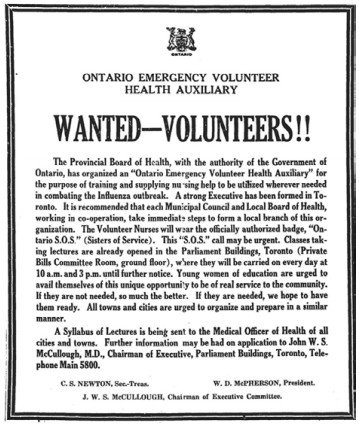The Spanish Flu, 1918
Ottawa’s last great epidemic
François Bregha
With the coronavirus ever present in the news, it is appropriate to remember the last great epidemic to sweep the region a little over a hundred years ago, the “Spanish Flu.” In late September 1918, Ottawa recorded its first case of “Spanish” influenza, roughly two weeks after the first Canadian cases had been identified in Quebec City. Not recognized for another week as the threat it would become, the epidemic was coming at the worst possible time. Canada had already lost tens of thousands of men in the war, and the ranks of its health care professionals still in the country were severely stretched because of military service. The unusually virulent strain of influenza which disproportionately affected the most active members of society—young adults, rather than the old and the very young—made an already bad situation worse.
The impacts were devastating. Particularly poignant were stories of entire families stricken by disease, too weak to leave home to seek help. Working- class neighbourhoods were particularly hard hit because they were close to railway stations—the main vector for the long-distance transmission of the virus—and their inhabitants tended to live in crowded and unsanitary housing. However, no neighbourhood was spared. At the height of the outbreak, Ottawa counted 50 deaths a day from the flu.
 The economic impacts were also severe: train schedules were disrupted because so many employees were sick; telephone services were reduced because of the depleted number of switchboard operators; and production fell at many factories.
The economic impacts were also severe: train schedules were disrupted because so many employees were sick; telephone services were reduced because of the depleted number of switchboard operators; and production fell at many factories.
To respond to this crisis, the City put in place extraordinary measures and mobilized its entire healthy population. On October 4, the Board of Health banned all forms of public assembly to check the progress of the disease: schools, taverns, concert halls, bowling alleys, billiard parlours and theatres were all ordered closed. A few days later, churches cancelled Sunday services. Businesses, and later government offices, were asked to close at 4 p.m. because it was believed that, “the vitality of the average person is at its lowest between 4 in the afternoon and 9 at night.” Employees who relied on their daily wages to make ends meet suffered financial hardships as a result of this enforced cut in their workday.
A suggestion to relax provincial liquor laws to allow limited purchases of alcohol without a doctor’s prescription, however, was turned down. These measures were in force—although not always respected—for five weeks, until Armistice Day, by which time the epidemic had clearly subsided and normal life could resume.
The City opened several temporary hospitals during this period as regular hospitals could not cope, the first being a former University of Ottawa dormitory on Laurier Avenue East. With a shortage of medical staff, the City sent out urgent calls for volunteer nurses to take care of the sick. Answering the call were 1,500 women. They cooked, sewed, distributed food and clothing, and helped nurse the sick. In the City Council Chambers, 300 volunteer seamstresses worked to equip hospitals with bedding, night clothes for the patients, face masks and “pneumonia jackets” (padded jackets that were believed to reduce infection) for the caregivers, and shrouds for the deceased.
 And that was not all. The Boy Scouts were put to work distributing flyers from the Board of Health to thousands of private homes. The Local Council of Women operated soup kitchens that made and distributed broth for flu patients. Dozens of volunteer drivers lent their cars to ferry nurses and supplies to the sick.
And that was not all. The Boy Scouts were put to work distributing flyers from the Board of Health to thousands of private homes. The Local Council of Women operated soup kitchens that made and distributed broth for flu patients. Dozens of volunteer drivers lent their cars to ferry nurses and supplies to the sick.
This extraordinary effort eventually paid off; Ottawa pulled through the crisis. It is worth noting that the federal government played no role in health care in those days. It would set up a department of health only in 1919 as a direct response to the epidemic. The Province of Ontario had effectively delegated the main responsibilities for fighting the flu to local authorities. So the city fought the epidemic essentially on its own. Over the five weeks that it lasted in the city, the epidemic claimed over 500 lives, as many as the city lost during the Great War, but in a much shorter period of time. It is estimated that between 10% and 25% of Ottawa’s population of about 100,000 became infected during this period.
